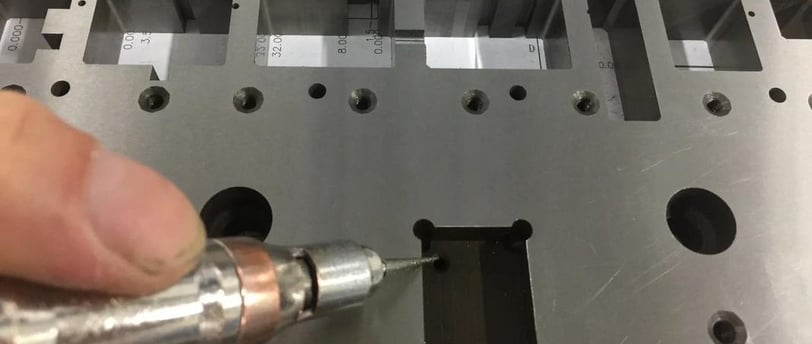How to Design a Stamping Die Suitable for Mass Production
2/22/2025


Understanding the Basics of Stamping Die Design
Stamping dies are specialized tools utilized in manufacturing processes to cut, shape, or form materials, predominantly metal, through a stamping press. The primary purpose of stamping dies is to facilitate mass production by producing consistent and precise parts in a highly automated environment. This process is essential across various industries, including automotive, electronics, and consumer goods, where high-volume production demands efficiency and accuracy.
There are several types of stamping dies employed in mass production, each designed to cater to specific needs. Three common types include progressive dies, compound dies, and simple dies. Progressive dies are engineered to perform multiple operations in a single press stroke, allowing for the sequential processing of a workpiece. This type of die is advantageous for high-volume production, as it significantly reduces handling time and enhances overall efficiency.
Compound dies, on the other hand, carry out two or more operations simultaneously at one station in the die. This type is ideal for simpler parts requiring multiple cuts or forms in a single press cycle. Simple dies are the most basic type and are primarily used for single operations, such as cutting or blanking, making them suitable for smaller production runs or simpler designs.
Understanding key terms and principles in die design, such as clearance, die components, and material flow, is crucial for any manufacturing professional. Clearance refers to the gap between the die and the material being stamped, impacting the finish and precision of the cut. Additionally, knowledge of die components—including punches, dies, and guides—along with material flow principles, ensures the effective design of stamping dies that meet production requirements. This foundational knowledge is necessary for anyone looking to delve deeper into advanced die design principles.
Key Considerations in Designing for Mass Production
When embarking on the design of a stamping die for mass production, several critical factors must be prioritized to ensure the end product meets both quality and efficiency standards. One of the foremost considerations is material selection. The choice of materials directly influences the die's performance and lifespan. High-strength, wear-resistant materials are often preferred to withstand the forces and friction encountered during high-volume stamping operations. Additionally, the material's ability to withstand thermal expansion and contraction can have a significant impact on the precision of stamped parts.
Another essential factor is die geometry. The design of the die should promote smooth material flow and minimize the risk of defects. This includes ensuring that the geometry allows for easy ejection of the final products while maintaining tight tolerances. The geometric configuration also plays a significant role in how stresses are distributed throughout the die, contributing to its overall durability. Additionally, the design should consider the layout of the die to facilitate ease of alignment and setup during the manufacturing process, which can greatly enhance production efficiency.
Tolerances are equally crucial in stamping die design, as they determine the allowable variation in dimensions and shapes of the stamped components. Achieving tight tolerances can lead to higher-quality products and reduce the need for rework. Any deviations can result in increased scrap rates and overall costs, undermining the advantages of mass production. Therefore, meticulous attention to tolerances ensures that each part produced remains within specified limits, contributing to consistent quality.
Lastly, the durability of the stamping die is imperative for sustained production efficiency. A robust design that considers the anticipated wear and tear will not only reduce maintenance costs but also enhance the reliability of operations. Ultimately, addressing these key considerations will lead to a more effective stamping die design tailored for mass production, optimizing both efficiency and cost-effectiveness while upholding the quality of the final output.
Design Process and Tools for Stamping Dies
The design of a stamping die suitable for mass production is a multifaceted process that involves several critical steps. Initially, the process commences with the formulation of an initial concept, where the requirements of the project are outlined. At this stage, it is essential to consider factors such as the type of material, the desired shape, and the production volume. Each of these elements plays a pivotal role in shaping the design direction.
Once the concept is established, the use of design software becomes crucial. Advanced Computer-Aided Design (CAD) software enables engineers and designers to create detailed digital representations of the die. These tools not only aid in visualizing the design but also facilitate modifications and improvements, allowing for a more refined product. CAD software helps ensure that all specifications align with the necessary production standards, thus optimizing the design for manufacturing.
Another critical aspect of the design process is the use of simulations. Through simulation software, designers can predict how the die will perform under various conditions, which is vital for identifying potential issues early in the development phase. Simulating the stamping process assists in assessing factors like material flow, shear ratios, and potential defects, guiding changes before a physical prototype is produced.
Prototyping is the next phase, where a physical model of the die is created. This step is essential for testing the functionality and ensuring that the design meets the intended specifications. Using materials that closely resemble the final product can yield valuable insights which foster further refinement. Additionally, engineers should aim to design with efficiency in mind, utilizing strategies that minimize material waste. By prioritizing efficient designs, manufacturers can enhance production timelines, reduce costs, and contribute to more sustainable practices.
Testing and Refining the Stamping Die Design
The process of designing a stamping die is multifaceted, and one of the most crucial stages is testing and refining the die design. Prior to embarking on full-scale production, it is essential to conduct thorough evaluations to ensure that the design functions as intended and meets the desired specifications. Various testing methods can be employed, such as trial runs and mold flow analysis, which play a pivotal role in identifying potential issues that can arise during mass production.
Trial runs involve creating a limited number of parts using the stamping die to observe its performance under real-world conditions. This stage allows for the detection of any inconsistencies or defects in the parts produced. By scrutinizing these initial outputs, designers can gain insights into the die’s functionality and make necessary adjustments to optimize its operation. Mold flow analysis, on the other hand, is a simulation technique that visualizes how material flows within the die. This method is instrumental in predicting issues related to material distribution and can highlight areas where the design may need refinement.
Feedback gathering is another critical component in the refining process. Insights from operators, quality assurance teams, and production staff can provide valuable perspectives on the die's performance. By engaging with individuals who interact with the die on a daily basis, designers can uncover areas for improvement that may not be apparent through testing alone. Further, implementing an iterative design process allows for continuous enhancements based on collected feedback and testing outcomes. This cyclical approach fosters an environment in which efficiency and quality can be improved over time, ultimately leading to a stamping die that is well-suited for the rigors of mass production.
